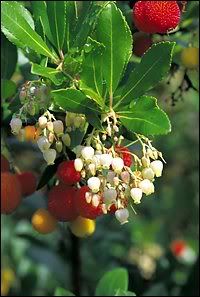

Arbutus (Arbutus unedo)
Folk Names: Strawberry Tree
Description: The arbutus evergreen spreads from the Mediterranean and Iberian Peninsula to Asia Minor and Killarney, Ireland. It is a member of heather family and prefers non-alkaline sandy loams. When first getting started, the tree requires some protection during winters, but older trees are quite hardy. Though some older trees are sometimes killed by harsh cold, most will invariably send up new shoots in the spring. Growing quickly in sheltered places, it is not a plant which likes shade however.
Though classified as a tree, the arbutus remains shrubby unless it is grown in its ideal conditions. Arbutus will grow up to sixteen feet, though occasionally twice that, but it is slow growing. It has reddish bark, especially on the branches, which cracks as the tree grows older. The small, glossy leaves are elliptical and acuminate, narrowing at base. The white, pitcher-shaped flowers are often suffused with pink or green. They grow in terminal racemes of only a few flowers each in autumn or near the beginning of winter along side the previous year's fruit, which have finally ripened at this time. The fruits resemble small strawberries. They are round berries containing a great number of seeds in fleshy pulp. The outside of the fruit is pimply and turns from green to yellow and orange and then to red when fully ripe.
Effects: strong
Planet: Mars
Element: fire
Associated Deities: Cardea
Traditions:
none noted
Magic:
The Romans used arbutus, under the guardianship of Cardea, to chase away evil and protect children. In Greece, it was also used for exorcisms, another facet of Cardea’s responsibilities.
Known Combinations:
none noted
Medical Indications: Parts Used:
none noted
Nutrition:
The fruit is edible, but lacks flavor. It might be used to make jams and jellies however. Eaten in quantity, it is said to be narcotic, a quality also ascribed to a wine made from the berries in Spain.
Mercantile Uses:
Virgil recommended the young shoots for winter fodder for goats and for basket weaving. In Greece and Spain, the bark has been put to use in tanning, and the wood may be used for charcoal making. By and large though, the ancients used the tree for landscape and aesthetic purposes. It is used mainly for hedges in Algiers. Thrushes, blackbirds, and other wild birds will eat the berries if you’d like to grow the tree for the benefit of our avian friends. The species is resistant to fire and is used in reforestation, reinforcement of dunes, and soil protection.